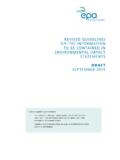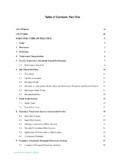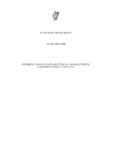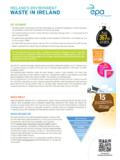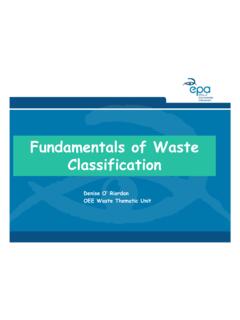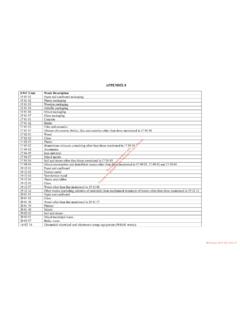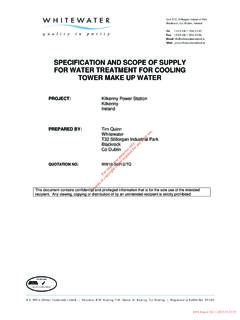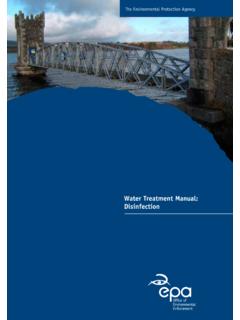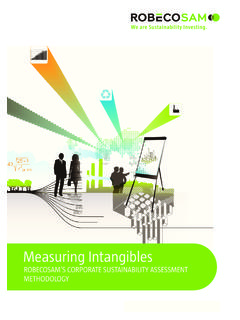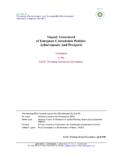Transcription of GUIDELINES ON THE INFORMATION TO BE …
1 GUIDELINES ON THE INFORMATION TO BE contained IN environmental impact assessment REPORTS DRAFT AUGUST 2017 environmental PROTECTION AGENCY The environmental Protection Agency (EPA) is responsible for protecting and improving the environment as a valuable asset for the people of Ireland. We are committed to protecting people and the environment from the harmful effects of radiation and pollution. The work of the EPA can be divided into three main areas:Regulation: We implement effective regulation and environmental compliance systems to deliver good environmental outcomes and target those who don t comply. Knowledge: We provide high quality, targeted and timely environmental data, INFORMATION and assessment to inform decision making at all : We work with others to advocate for a clean, productive and well protected environment and for sustainable environmental ResponsibilitiesLicensingWe regulate the following activities so that they do not endanger human health or harm the environment: waste facilities ( landfills, incinerators, waste transfer stations); large scale industrial activities ( pharmaceutical, cement manufacturing, power plants); intensive agriculture ( pigs, poultry); the contained use and controlled release of Genetically Modified Organisms (GMOs).
2 Sources of ionising radiation ( x-ray and radiotherapy equipment, industrial sources); large petrol storage facilities; waste water discharges; dumping at sea activities. National environmental Enforcement Conducting an annual programme of audits and inspections of EPA licensed facilities. Overseeing local authorities environmental protection responsibilities. Supervising the supply of drinking water by public water suppliers. Working with local authorities and other agencies to tackle environmental crime by coordinating a national enforcement network, targeting offenders and overseeing remediation. Enforcing Regulations such as Waste Electrical and Electronic Equipment (WEEE), Restriction of Hazardous Substances (RoHS) and substances that deplete the ozone layer.
3 Prosecuting those who flout environmental law and damage the Management Monitoring and reporting on the quality of rivers, lakes, transitional and coastal waters of Ireland and groundwaters; measuring water levels and river flows. National coordination and oversight of the Water Framework Directive. Monitoring and reporting on Bathing Water , Analysing and Reporting on the Environment Monitoring air quality and implementing the EU Clean Air for Europe (CAF ) Directive. Independent reporting to inform decision making by national and local government ( periodic reporting on the State of Ireland s Environment and Indicator Reports). Regulating Ireland s Greenhouse Gas Emissions Preparing Ireland s greenhouse gas inventories and projections.
4 Implementing the Emissions Trading Directive, for over 100 of the largest producers of carbon dioxide in Ireland. environmental Research and Development Funding environmental research to identify pressures, inform policy and provide solutions in the areas of climate, water and environmental assessment Assessing the impact of proposed plans and programmes on the Irish environment ( major development plans). Radiological Protection Monitoring radiation levels, assessing exposure of people in Ireland to ionising radiation. Assisting in developing national plans for emergencies arising from nuclear accidents. Monitoring developments abroad relating to nuclear installations and radiological safety.
5 Providing, or overseeing the provision of, specialist radiation protection , Accessible INFORMATION and Education Providing advice and guidance to industry and the public on environmental and radiological protection topics. Providing timely and easily accessible environmental INFORMATION to encourage public participation in environmental decision-making ( My Local Environment, Radon Maps). Advising Government on matters relating to radiological safety and emergency response. Developing a National Hazardous Waste Management Plan to prevent and manage hazardous waste. Awareness Raising and Behavioural Change Generating greater environmental awareness and influencing positive behavioural change by supporting businesses, communities and householders to become more resource efficient.
6 Promoting radon testing in homes and workplaces and encouraging remediation where and Structure of the EPA The EPA is managed by a full time Board, consisting of a Director General and five Directors. The work is carried out across five Offices: Office of environmental Sustainability Office of environmental Enforcement Office of Evidence and assessment Office of Radiological Protection and environmental Monitoring Office of Communications and Corporate Services The EPA is assisted by an Advisory Committee of twelve members who meet regularly to discuss issues of concern and provide advice to the NOTES ON THIS DRAFT\\this draft is provided to help practitioners during the transition to new regulations\\this draft of the revised GUIDELINES will be reviewed when the new regulations transposing Directive 2014/52/EU are available - to ensure that content is consistent with the regulations and to update specific
7 Legislative references all references to transposing legislation will be reviewed\\revised Advice Notes will be published after the GUIDELINES have been adopted and published\\an accompanying webpage will be made available after the GUIDELINES have been adopted and published\\external hyperlinks are shown with a blue rule below, internal links with a green rule below and links to external sources which will be available in the future with a red rule 3 of Directive 2014 / 52 / EU1. Projects in respect of which the determination referred to in Article 4(2) of Directive 2011/92/EU was initiated before 16 May 2017 shall be subject to the obligations referred to in Article 4 of Directive 2011/92/EU prior to its amendment by this Projects shall be subject to the obligations referred to in Article 3 and Articles 5 to 11 of Directive 2011/92/EU prior to its amendment by this Directive where, before 16 May 2017:a) the procedure regarding the opinion referred to in Article 5(2) of Directive 2011/92/EU was initiated.
8 Orb) the INFORMATION referred to in Article 5(1) of Directive 2011/92/EU was impact assessment Reports | Draft GuidelinesPage: iTABLE OF CONTENTS1. INTRODUCTION Introduction Key Changes in the amended Directive The Purpose of the GUIDELINES Structure of the GUIDELINES 32. CONTEXT AND GENERAL APPROACH Introduction What is an environmental impact assessment report ? Overview of the EIA Process Fundamental Principles Anticipating, Avoiding and Mitigating Significant Effects Maintaining Objectivity Ensuring Clarity and Quality Providing Relevant INFORMATION to Decision Makers Facilitating Better Consultation Competency of Experts Consultation 143.
9 PREPARING AN EIAR Introduction Screening (Stage 1 of 7) INTRODUCTION Project Type Thresholds Consultation on Screening Scoping (Stage 2 of 7) Overview Participants in Scoping Consultation about Scoping Key Scoping Criteria Consideration of Other Assessments Selection of Headings Under Which to Arrange Issues Ongoing Scoping Design Review Consideration of Alternatives (Stage 3 of 7) Overview Do-Nothing Alternative Alternative Locations Alternative Layouts Alternative Designs Alternative Processes Alternative Mitigation Measures Consultation about Consideration of Alternatives Describing the Proposed Project (Stage 4 of 7) Introduction Characteristics of the Project Description of Construction 39 Page.
10 IiEnvironmental impact assessment Reports | Draft Description of Commissioning The Operation of the Project Changes to the Project Description of Other Related Projects Level of Detail in Project Description Describing the Baseline (Stage 5 of 7) Overview Methodology Grouping of Baseline INFORMATION Range and Level of Detail of Baseline INFORMATION impact assessment (Stage 6 of 7) Introduction Documenting the Process Descriptions of Effects impact assessment Criteria assessment Methods Interactions Between Impacts on Different Factors Mitigation & Monitoring (Stage 7 of 7) Mitigation Monitoring Consultation about Predicted Impacts, Mitigation & Monitoring Measures Clarity of Mitigation & Monitoring Measures Residual Impacts & Conclusions Residual Impacts Conclusions Document Review 624.
